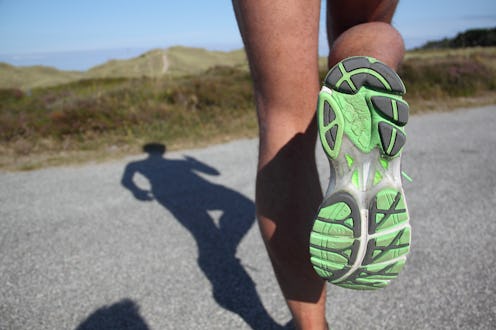Fashion
How To Shop For The Right Running Shoes

Competitive runners know that picking the right running shoes can save the valuable fractions of a second that often mean the difference between a win and a loss. But, even if you're hitting the pavement (or beach or back-country) recreationally, taking the time to find your ideal running shoe is crucial.
Wearing the wrong shoes leaves you more vulnerable to injury, makes running harder (and, really, isn't it hard enough already?), and puts additional strain on the muscles used when you run. So, how do you know the right shoe from the wrong one? That's where we come in. Check out this quick and dirty guide to finding your feet's happiest home.
Here are 6 tips that'll help you pick the best running shoes for your feet and running style.
1. Stay Current
Running shoes last between 400 and 500 miles, so it depends how often you're hitting the trail. Regular runners will need new shoes about every 3-4 months. If you've been using your pair for more than half a year, it might be time to switch it up.
2. Take The Wet Test
Your striking pattern is what determines the kind of shoe you need, so knowing the terminology will make your next trip to the shoe store way easier. If you're not sure what kind of foot you have, try the wet test.
Wet your feet and stand on a piece of paper or paper bag. If there's a noticeable curve connecting your heel and your toes (about half the width of your foot), you have a normal arch. A sharp curve between heel and toe with a very thin band between them (or, if you're like me, the disappearance of the entire middle portion of your foot) means you've got high arches. Almost no curve between heel and toe, AKA a foot that's nearly the same width throughout, suggests low arches or flat feet.
3. Learn The Lingo
Pronation sounds like something from a Transformers movie, but it's really just the term that describes patterns identified in the wet test. We run differently to compensate for the shapes of our feet, and that can cause injury. The right shoe will support and help correct any tendency to put pressure on your muscles and joints. So, knowing how you pronate is the best way to make sure you're running safely and that you don't end up feeling like this.
People with high arches tend to under-pronate. Translation: The outer edge of your foot bears the brunt of your weight, because you have little to no support on the inside of your foot. People with flat feet do just the opposite, rolling too far inward (over-pronating). The lucky folks with normal arches land in the middle (pun intended). They're normal pronators.
4. Try Before You Buy
Once you know what your feet need, it'll be easy to shop online for stabilizing or high-support shoes. However, running shoes are like jeans. They might tick all the boxes in theory, but until you've wiggled around in them a bit, you won't know if they really feel right.
Some shoe stores will let you run around the parking lot and some have a treadmill in the store, but at the very least, you can bounce up and down or jog around the room before plunking down your credit card.
5. Have Dedicated Racing Shoes
Planning to run competitively? You'll need minimalist shoes, which are lighter than the average running shoe. Still, make sure you get a pair of traditional, more supportive running shoes for training. Wearing racing shoes regularly is a surefire way to get yourself sidelined with an injury. Much like this:
6. Shop, Shop, Shop!
Now that you're a pronating pro, you can find the best shoe for you faster than Usain Bolt runs a 100m. Here are a few foot type-specific options to browse before you hit the mall.
Under-pronation (little to no arch imprint in the wet test):
Try a neutral cushioning shoe, like the Asics Gel-Nimbus 17 or New Balance 1400v3.
Neutral runners (defined arch about half the width of the foot):
Go for a stability shoe, like the New Balance 940v2 or Nike LunarGlide 6 FlashiD.
Low arches and flat feet (most of your foot shows in the wet test imprint):
Your best bet is a motion control shoe, like the Brooks Addiction 11 or Mizuno Wave Alchemy 12.
I hope this helps you find your perfect pair. But, since you can't use a new pair of shoes to motivate every run, I'll let you in on my secret weapon workout playlist. Crank it up next time you need a little extra mojo. See you at the finish line.
Images: GrejGuide.dk/Flickr, Brittanyb111/gifsoup, giphy(4), Poppybarley